
|

 

The Dig by LucasArts

 LucasArts' new adventure game combines the directing talents of Steven Spielberg and the special
effects wizards at the renowned Industrial Light and Magic for a gaming experience that lives up
to the LucasArts name. Never once have I been dissatisfied with a LucasArts game, and this is no
exception.
LucasArts' new adventure game combines the directing talents of Steven Spielberg and the special
effects wizards at the renowned Industrial Light and Magic for a gaming experience that lives up
to the LucasArts name. Never once have I been dissatisfied with a LucasArts game, and this is no
exception.
With an immense world to explore and discover, full-screen video and stereo sound, The Dig creates
the best atmosphere I've ever seen - no, felt. The game is so realistic, the screens so beautiful,
the sound effects so startlingly real that you begin to feel like you really are there, that you
really are lost on this planet far away from home.
First off, what's The Dig about?
The Plot

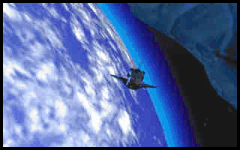 In a desolated Deep Space Observatory station in hot and humid Borneo, a small blinking dot
appears on the amber screen. The computer, recognizing an object that could become a threat to
earth, quickly calculates the odds of impact. The lone operator's heart skips a beat as the words
"Probability of impact with earth: 1 in 1" appears. He quickly places a phone call which will
change your life, as NASA veteran Boston Low, forever.
In a desolated Deep Space Observatory station in hot and humid Borneo, a small blinking dot
appears on the amber screen. The computer, recognizing an object that could become a threat to
earth, quickly calculates the odds of impact. The lone operator's heart skips a beat as the words
"Probability of impact with earth: 1 in 1" appears. He quickly places a phone call which will
change your life, as NASA veteran Boston Low, forever.
Your mission, as commander of the shuttle Atlantis, is to divert the moon-sized asteroid, named
Attila (after the 5th century Hun leader), and save the planet from a devastating impact. Once the
wayward asteroid is nuked into a safe orbit, you and your team, consisting of award-winning
journalist Maggie Robbins and internationally renowned geologist Ludger Brink, conduct a routine
examination of the rocky surface.
What you uncover is anything but routine.
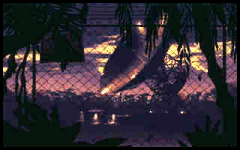 Unwittingly, you trigger a mechanism that transforms the asteroid into a crystal-like spacecraft.
You and your team are hurtled across the galaxy to a planet so desolate, Brink is moved to name it
Cocytus, after the 9th circle of Hell in Dante's Inferno. The bleak landscape was obviously once
home to a highly developed civilization, with remnants of sophisticated architecture, advanced
technology and an intricate network of underground tunnels. But no Cocytans.
Unwittingly, you trigger a mechanism that transforms the asteroid into a crystal-like spacecraft.
You and your team are hurtled across the galaxy to a planet so desolate, Brink is moved to name it
Cocytus, after the 9th circle of Hell in Dante's Inferno. The bleak landscape was obviously once
home to a highly developed civilization, with remnants of sophisticated architecture, advanced
technology and an intricate network of underground tunnels. But no Cocytans.
Who were the original inhabitants of this once rich empire-turned-wasteland? What are those
apparitions that mysteriously appear from time to time? Why have Low, Robbins and Brink been
brought to this place? And how can Low keep his team from unraveling in the face of such
uncertainty? To return to Earth the team must dig for answers, both on the planet's surface and
deep within themselves.
Plot Rating:      This story line has excellent potential and makes an exciting game.
This story line has excellent potential and makes an exciting game.
The Graphics

Although the graphics are standard 320x240 VGA, it still amazes me how much these guys at
LucasArts can pack into a small space. As with their previous two games, Full Throttle and Sam &
Max Hit The Road, LucasArts has done away with any permanent on-screen interface and left the
screen exclusively for the environment.
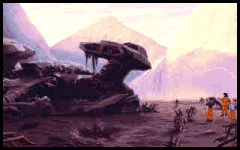 There are two graphic "modes" that LucasArts has employed, "interface mode" and "video mode". For
the former, it is just as their other games are done, where you move and interact in a painted
background. In the latter, "video mode", the screen switches to a cartoon-like full screen movie,
which is at times quite stunning, and at others a little disappointing. In certain scenes, such as
in the introduction where the shuttle bay doors open, the screen becomes blocky; areas where you
would expect a smooth graduation in colors are jagged. This is a result of having only 256 colors
to work with. LucasArts has kept with 320x240@256 colors since the famous Secret Of Monkey Island.
If LucasArts would provide an option for the now popular 640x480 resolution, and even better with
16-bit colors, many visual problems would be solved.
There are two graphic "modes" that LucasArts has employed, "interface mode" and "video mode". For
the former, it is just as their other games are done, where you move and interact in a painted
background. In the latter, "video mode", the screen switches to a cartoon-like full screen movie,
which is at times quite stunning, and at others a little disappointing. In certain scenes, such as
in the introduction where the shuttle bay doors open, the screen becomes blocky; areas where you
would expect a smooth graduation in colors are jagged. This is a result of having only 256 colors
to work with. LucasArts has kept with 320x240@256 colors since the famous Secret Of Monkey Island.
If LucasArts would provide an option for the now popular 640x480 resolution, and even better with
16-bit colors, many visual problems would be solved.
Visual effects were created by Industrial Light and Magic, the company which practically does all
special effects today. Not trying to give anything away, I'll just say that these are the kind of
effects you'd expect in blockbuster movies.
Graphics Rating:     While the graphics are beautiful, VGA resolution is becoming outdated. If LucasArts had done this game in 640x480@16-bit it would receive 5 stars.
While the graphics are beautiful, VGA resolution is becoming outdated. If LucasArts had done this game in 640x480@16-bit it would receive 5 stars.
The Sound

One thing you'll notice in The Dig's setup program is the lack of a MIDI option. This is because
LucasArts has done away with not just the AdLib standard, but with MIDI altogether and created the
first quality digital soundtrack I have heard. Combining the smooth tones of Wagner compositions
and realistic sound effects, the soundtrack is probably the game's best attribute. While the tones
become repetitive after hours of gameplay, they are still the best to be heard on any game I've
played.
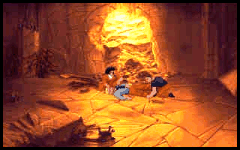 Combined with the music are startling sound effects - and I do mean startling. When I first
entered the interior of the asteroid the popping and cracking of the freshly-nuked rock sounded
like it was coming from all around me - I at first thought something odd was happening to my
house. The voice-overs, written by Orson Scott Card and Sean Clark, are well done; read with
excellent emotion and emphasis. Robert Patrick of Terminator 2 fame voiced Boston Low. To hear
the full impact of this game be sure to have a quality sound card and even better speakers - don't
stick with those 50-cent squawkers that came with the system.
Combined with the music are startling sound effects - and I do mean startling. When I first
entered the interior of the asteroid the popping and cracking of the freshly-nuked rock sounded
like it was coming from all around me - I at first thought something odd was happening to my
house. The voice-overs, written by Orson Scott Card and Sean Clark, are well done; read with
excellent emotion and emphasis. Robert Patrick of Terminator 2 fame voiced Boston Low. To hear
the full impact of this game be sure to have a quality sound card and even better speakers - don't
stick with those 50-cent squawkers that came with the system.
Sound Rating:     The music is alluring if repetitive, the sound effects exciting, and the dialogue professional. With more variance in the music this soundtrack would rate 5 stars.
The music is alluring if repetitive, the sound effects exciting, and the dialogue professional. With more variance in the music this soundtrack would rate 5 stars.
The Interface

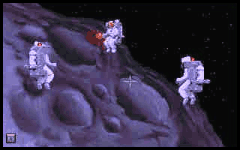 As mentioned above, LucasArts has totally done away with the on-screen interface and gone with
point-and-click of late. The Dig has the most basic interface yet. While games started off with
many different text-only designs, the first graphics-intensive games brought about the need for a
quicker interface, namely "choose-an-action-and-click".
As mentioned above, LucasArts has totally done away with the on-screen interface and gone with
point-and-click of late. The Dig has the most basic interface yet. While games started off with
many different text-only designs, the first graphics-intensive games brought about the need for a
quicker interface, namely "choose-an-action-and-click".
With The Dig you don't have to cycle through the talk-walk-look-get actions. For example, if you
click on a person, you talk to them. Your inventory is controlled by either right-clicking the
mouse or clicking on a small box on the bottom-left of the screen. There is an "examine" tool
which gives you a close look at objects, and you'll find yourself using it often. To use an object
you drag it off the "box" and click on what you want to use it with. It is a quick and simple
interface, one which allows you to experience the game as Commander Low rather than fight to
figure out the right combination of commands.
My favorite time-saving feature was the option of double-clicking on a destination (to another
screen) and instantly going there instead of watching the figure walk around, which happens when
you single-click.
Interface Rating:     Quick and simple best describes the latest in point-and-click.
Quick and simple best describes the latest in point-and-click.
The Gameplay

The Dig traps you on an alien world where it is your task to keep control of your crew, survive,
and get home. You've got your work cut out for you. Not only does your crew want nothing to do
with you, but the previous tenants of the planet seem to have left, and there aren't any ships
laying about to take you home.
Most of the gameplay involves exploring the alien complex and learning about the former occupants.
There are puzzles to solve and clues to decipher. Most of the game moves quickly, the only sticky
points being the puzzles. In these, you are presented with an alien piece of machinery which,
typical with all old alien equipment, doesn't work. Your goal is to repair it - the only problem
being you don't know what it's supposed to do!
While most of the puzzles could be figured out if you spent enough time at them, most will require
a bit of help. The Dig felt much longer and more solid than other recent LucasArts games, I'm sure
it will keep you going for at least a month. The story line is long - Alan Dean Foster even wrote
a novel based on this game.
Gameplay Rating:     If LucasArts had been a little less vague with the puzzles this would be 5 stars.
If LucasArts had been a little less vague with the puzzles this would be 5 stars.
The Whole Shebang

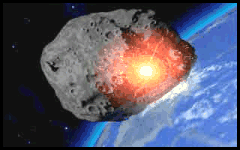 I like this game. I really do. For all the little nit-picks I do, I am really impressed with it. I
wholeheartedly recommend it to any computer game guru who enjoys a good adventure. It flows
smoothly and keeps one entertained. One warning, though. While this game is rated "Kids to Adults"
on the box, there are several scenes which made even me cringe, so I can't recommend it to kids
under 12. This game comes under the same category as the movie Jurassic Park: There's no swearing,
no sex, no needless violence, and (surprise!) it's still a great mature game. (DT)
I like this game. I really do. For all the little nit-picks I do, I am really impressed with it. I
wholeheartedly recommend it to any computer game guru who enjoys a good adventure. It flows
smoothly and keeps one entertained. One warning, though. While this game is rated "Kids to Adults"
on the box, there are several scenes which made even me cringe, so I can't recommend it to kids
under 12. This game comes under the same category as the movie Jurassic Park: There's no swearing,
no sex, no needless violence, and (surprise!) it's still a great mature game. (DT) 

|
DATA BOX |
 | |  | |
Requirements:
486DX2-66 processor, 8mb RAM, 1mb hard drive space, VLB or PCI VGA graphics, 2x CD-ROM, DOS 6.0 or better, Sound Blaster compatible sound card, mouse.
Recommended:
Pentium processor, 16mb RAM, 4x CD-ROM.
Protection:
None (CD must be in drive)
Catagory:
SciFi Adventure
Publisher:
LucasArts
| |  |
| 
|
THE LAST WORD |
 | |  | |
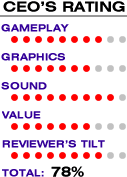 Pros:
The Dig has good artwork and one of the first quality digital sound tracks. Atmosphere is
excellent, as are voice overs.
Pros:
The Dig has good artwork and one of the first quality digital sound tracks. Atmosphere is
excellent, as are voice overs.
Cons:
Low resolution and a limited color palette spoil some complicated scenes, while obscure puzzles
make this game more frustrating than challenging at times.
| |   |
|

©1996-1998 Sunstorm Systems®. All rights reserved.
| 
|
 LucasArts' new adventure game combines the directing talents of Steven Spielberg and the special
effects wizards at the renowned Industrial Light and Magic for a gaming experience that lives up
to the LucasArts name. Never once have I been dissatisfied with a LucasArts game, and this is no
exception.
LucasArts' new adventure game combines the directing talents of Steven Spielberg and the special
effects wizards at the renowned Industrial Light and Magic for a gaming experience that lives up
to the LucasArts name. Never once have I been dissatisfied with a LucasArts game, and this is no
exception.
 In a desolated Deep Space Observatory station in hot and humid Borneo, a small blinking dot
appears on the amber screen. The computer, recognizing an object that could become a threat to
earth, quickly calculates the odds of impact. The lone operator's heart skips a beat as the words
"Probability of impact with earth: 1 in 1" appears. He quickly places a phone call which will
change your life, as NASA veteran Boston Low, forever.
In a desolated Deep Space Observatory station in hot and humid Borneo, a small blinking dot
appears on the amber screen. The computer, recognizing an object that could become a threat to
earth, quickly calculates the odds of impact. The lone operator's heart skips a beat as the words
"Probability of impact with earth: 1 in 1" appears. He quickly places a phone call which will
change your life, as NASA veteran Boston Low, forever. Unwittingly, you trigger a mechanism that transforms the asteroid into a crystal-like spacecraft.
You and your team are hurtled across the galaxy to a planet so desolate, Brink is moved to name it
Cocytus, after the 9th circle of Hell in Dante's Inferno. The bleak landscape was obviously once
home to a highly developed civilization, with remnants of sophisticated architecture, advanced
technology and an intricate network of underground tunnels. But no Cocytans.
Unwittingly, you trigger a mechanism that transforms the asteroid into a crystal-like spacecraft.
You and your team are hurtled across the galaxy to a planet so desolate, Brink is moved to name it
Cocytus, after the 9th circle of Hell in Dante's Inferno. The bleak landscape was obviously once
home to a highly developed civilization, with remnants of sophisticated architecture, advanced
technology and an intricate network of underground tunnels. But no Cocytans. There are two graphic "modes" that LucasArts has employed, "interface mode" and "video mode". For
the former, it is just as their other games are done, where you move and interact in a painted
background. In the latter, "video mode", the screen switches to a cartoon-like full screen movie,
which is at times quite stunning, and at others a little disappointing. In certain scenes, such as
in the introduction where the shuttle bay doors open, the screen becomes blocky; areas where you
would expect a smooth graduation in colors are jagged. This is a result of having only 256 colors
to work with. LucasArts has kept with 320x240@256 colors since the famous Secret Of Monkey Island.
If LucasArts would provide an option for the now popular 640x480 resolution, and even better with
16-bit colors, many visual problems would be solved.
There are two graphic "modes" that LucasArts has employed, "interface mode" and "video mode". For
the former, it is just as their other games are done, where you move and interact in a painted
background. In the latter, "video mode", the screen switches to a cartoon-like full screen movie,
which is at times quite stunning, and at others a little disappointing. In certain scenes, such as
in the introduction where the shuttle bay doors open, the screen becomes blocky; areas where you
would expect a smooth graduation in colors are jagged. This is a result of having only 256 colors
to work with. LucasArts has kept with 320x240@256 colors since the famous Secret Of Monkey Island.
If LucasArts would provide an option for the now popular 640x480 resolution, and even better with
16-bit colors, many visual problems would be solved. Combined with the music are startling sound effects - and I do mean startling. When I first
entered the interior of the asteroid the popping and cracking of the freshly-nuked rock sounded
like it was coming from all around me - I at first thought something odd was happening to my
house. The voice-overs, written by Orson Scott Card and Sean Clark, are well done; read with
excellent emotion and emphasis. Robert Patrick of Terminator 2 fame voiced Boston Low. To hear
the full impact of this game be sure to have a quality sound card and even better speakers - don't
stick with those 50-cent squawkers that came with the system.
Combined with the music are startling sound effects - and I do mean startling. When I first
entered the interior of the asteroid the popping and cracking of the freshly-nuked rock sounded
like it was coming from all around me - I at first thought something odd was happening to my
house. The voice-overs, written by Orson Scott Card and Sean Clark, are well done; read with
excellent emotion and emphasis. Robert Patrick of Terminator 2 fame voiced Boston Low. To hear
the full impact of this game be sure to have a quality sound card and even better speakers - don't
stick with those 50-cent squawkers that came with the system. As mentioned above, LucasArts has totally done away with the on-screen interface and gone with
point-and-click of late. The Dig has the most basic interface yet. While games started off with
many different text-only designs, the first graphics-intensive games brought about the need for a
quicker interface, namely "choose-an-action-and-click".
As mentioned above, LucasArts has totally done away with the on-screen interface and gone with
point-and-click of late. The Dig has the most basic interface yet. While games started off with
many different text-only designs, the first graphics-intensive games brought about the need for a
quicker interface, namely "choose-an-action-and-click". I like this game. I really do. For all the little nit-picks I do, I am really impressed with it. I
wholeheartedly recommend it to any computer game guru who enjoys a good adventure. It flows
smoothly and keeps one entertained. One warning, though. While this game is rated "Kids to Adults"
on the box, there are several scenes which made even me cringe, so I can't recommend it to kids
under 12. This game comes under the same category as the movie Jurassic Park: There's no swearing,
no sex, no needless violence, and (surprise!) it's still a great mature game. (DT)
I like this game. I really do. For all the little nit-picks I do, I am really impressed with it. I
wholeheartedly recommend it to any computer game guru who enjoys a good adventure. It flows
smoothly and keeps one entertained. One warning, though. While this game is rated "Kids to Adults"
on the box, there are several scenes which made even me cringe, so I can't recommend it to kids
under 12. This game comes under the same category as the movie Jurassic Park: There's no swearing,
no sex, no needless violence, and (surprise!) it's still a great mature game. (DT)  Pros:
The Dig has good artwork and one of the first quality digital sound tracks. Atmosphere is
excellent, as are voice overs.
Pros:
The Dig has good artwork and one of the first quality digital sound tracks. Atmosphere is
excellent, as are voice overs.